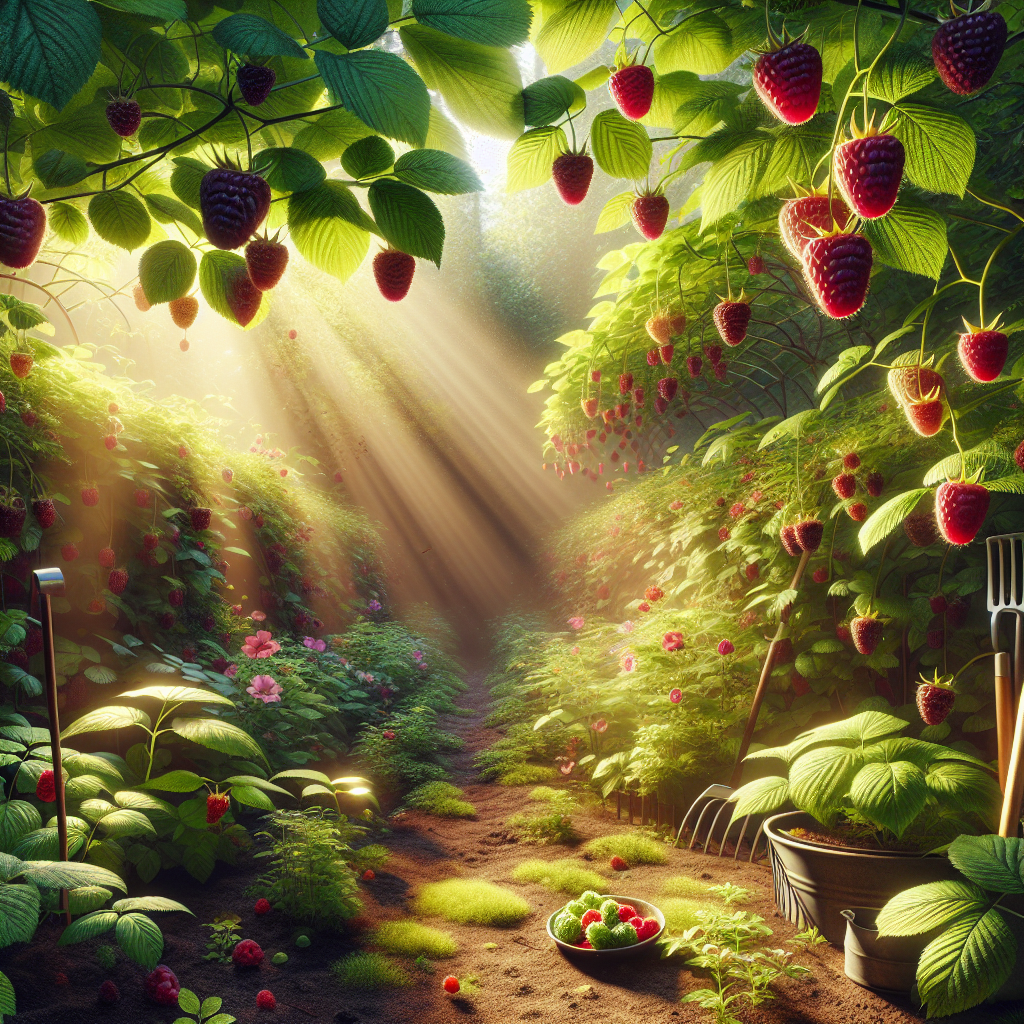Contents

Imagine stepping into your garden, the morning sun warming your back as you reach out and pluck a ripe, juicy raspberry from the vine. The sweet aroma fills the air, and with one taste, you’re reminded why growing your own fruit is unmatched. This is the sensory delight that awaits in a well-tended raspberry patch. Let’s dive into the world of raspberries and uncover how you can cultivate these gems in your own space.
Key Takeaways
-
Raspberries need full sun and well-drained soil to thrive.
-
There are summer-bearing and fall-bearing varieties to suit your garden’s needs.
-
Proper planting, watering, and pruning are key to a bountiful harvest.
-
Be vigilant about pests and diseases to keep your plants healthy.
-
Harvesting at the right time ensures the sweetest, most flavorful berries.
Sweet Beginnings: Raspberries in Your Garden
To get started, choose a sunny spot in your garden. Raspberries love the light, and they need at least six to eight hours of sunshine each day. They also prefer well-drained soil, so if you have heavy clay, consider raising your beds or amending the soil with compost to improve drainage.
The Lure of the Ruby Hues
The allure of raspberries goes beyond taste; their vibrant colors are a feast for the eyes. Raspberries aren’t just red; they come in shades of black, purple, and even golden yellow. Each variety not only brings its unique flavor profile but also adds a splash of color to your garden palette.
Taste the Difference: Homegrown vs. Store-Bought
There’s a stark difference between the raspberries you grow and those you buy at the store. Homegrown berries are fresher, sweeter, and have a depth of flavor that store-bought ones can’t match. This is because commercial varieties are often bred for durability during transport, not taste.
Luscious Varieties to Plant

Choosing the right variety is crucial. Do you want a summer treat or a fall surprise? Summer-bearing raspberries will give you a large crop in the middle of the season, while fall-bearing varieties offer fruit from late summer into the first frosts.
Summer Bliss: Early Fruiters
For those who can’t wait for that first berry burst, summer-bearing raspberries like ‘Boyne’ and ‘Killarney’ ripen in early summer. They’re perfect for that early-season snack and are often ready for harvest around the same time strawberries peak, making for a lovely berry duo.
Autumn Harvest: Late Blooming Raspberries
If you’re patient and want to extend your berry season, fall-bearing varieties like ‘Heritage’ and ‘Autumn Bliss’ are your go-to. They produce berries from late summer through to the fall, ensuring you have fresh raspberries at a time when other fruits are winding down.
Berries of Gold: Yellow and Golden Varieties
And let’s not forget the golden raspberries, like ‘Fall Gold’ and ‘Anne’, which offer a sweeter, milder taste. These unique berries are a delightful surprise to many and can be a real showstopper in any garden.
For those with a green thumb, the unique texture of raspberry bushes can be a delightful addition to any garden. Not only do these plants yield delicious fruit, but their distinctive, slightly hairy leaves add an interesting tactile element to the sensory experience of gardening.
The Right Way to Raspberry Riches

“Raspberries – Free Stock Photo by …” from www.stockvault.net
Before planting your raspberries, it’s important to prepare the ground. This means clearing the area of weeds, amending the soil with organic matter, and ensuring good drainage. Raspberries prefer a pH between 5.5 and 6.5, so it’s wise to test your soil and adjust accordingly. Once your site is prepped, it’s time to plant.
Setting Up Your Berry Patch
For a bountiful raspberry harvest, remember the three S’s: Sun, Soil, and Space. Full sun encourages maximum fruit production, rich soil yields healthy plants, and proper spacing allows for air circulation to prevent disease.
Space your raspberry plants about 18 to 24 inches apart, with rows set about 4 to 6 feet apart. This spacing allows for easy harvesting and adequate air circulation, which is crucial for plant health.
Planting bare-root raspberries in early spring as soon as the ground can be worked is ideal. If you’ve got potted plants, you can be a bit more flexible with timing. Either way, get those roots into the ground gently, and give them a good watering to settle them in.
Soil Secrets for Supreme Berries
Raspberries aren’t too picky, but they do best in soil that’s rich in organic matter. If your garden’s soil isn’t quite up to snuff, don’t worry. Work in some well-rotted compost or aged manure before planting, and you’ll be off to a good start. Keep adding organic matter each year to keep the soil fertile and your raspberries happy.
Watering Wisdom: Hydration Equals Berry Elation
When it comes to watering, consistency is key. Raspberries need 1 to 2 inches of water per week, more during dry spells. Use a soaker hose or drip irrigation to deliver water directly to the roots, where it’s needed most. This method also helps keep the leaves dry, which can reduce the risk of fungal diseases.
Befriending the Thorns: Plant Care

Raspberry canes have thorns, so when you’re working with them, a good pair of gloves is your best friend. Regular maintenance like weeding and mulching will keep your plants healthy and productive. Mulch helps retain moisture, keeps the weeds down, and adds organic matter to the soil as it breaks down.
Pruning for Prosperity
Pruning might seem daunting, but it’s all about timing and technique. For summer-bearing raspberries, prune canes that have fruited right after you harvest. For fall-bearing varieties, you can either prune all canes to the ground in late winter for a single late crop or prune only the spent canes if you want a summer and fall harvest.
Support Systems: Trellising Tips
Raspberry canes can get heavy with fruit, so they’ll need support. A simple trellis system can be made with posts and wires. Run two wires along the row at about 2 and 5 feet off the ground. As the plants grow, tie them loosely to the wires. This keeps the canes upright and makes harvesting a breeze.
Another popular method is the T-trellis system, where two horizontal wires form a ‘T’ with the main post. This provides ample support for the canes and allows for easy access from both sides of the row.
Raspberries have a few natural enemies, but with some know-how, you can keep them at bay. Birds love the berries as much as we do, so consider netting your plants to protect your crop. Insects and diseases can also be a problem, but many issues can be prevented with good cultural practices.
Pests: Uninvited Guests and How to Manage Them
Pests like the raspberry beetle and spider mites can be troublesome. Regular inspections of your plants will help you spot problems early. Handpicking pests or using insecticidal soaps can be effective for control. Encouraging beneficial insects, like ladybugs and lacewings, is also a great natural defense.
Diseases: Prevention and Cures for Common Ailments
Fungal diseases such as powdery mildew and raspberry leaf spot can be managed by proper plant spacing and air circulation. If you do encounter a disease, remove and destroy affected plant parts to prevent spread. In severe cases, a fungicide may be necessary, but always try less invasive methods first.
The Finest Hour: Harvesting Raspberries

“Raspberry Galette – Bakes by Brown Sugar” from bakesbybrownsugar.com
Harvest time is the most rewarding part of growing raspberries. When berries are plump, deeply colored, and come off the vine easily, they’re ready to be picked. Harvest in the cool of the morning and refrigerate your berries as soon as possible to maintain their quality.
Raspberries are best enjoyed fresh but can also be frozen, made into jams, or used in baking. Remember, they’re delicate, so handle with care to avoid crushing your precious bounty.
From Garden to Table: Storing and Savoring Your Berries
After the joy of harvesting, the next step is ensuring your raspberries make it to the table at their best. Quick refrigeration is key; it slows down deterioration and preserves the berries’ flavor and texture. If you can’t eat them all fresh—which is quite a challenge with raspberries as delicious as these—freezing is a fantastic option. Spread them out on a baking sheet to freeze individually, then transfer to a container. This way, you can enjoy the taste of summer even when the snow falls.
For a longer shelf life, raspberry jams and preserves are the way to go. The process of making jam is simple and rewarding, plus it makes a delightful gift. If you’re feeling adventurous, raspberries also make a delightful addition to sauces and can be used to create a sweet drizzle over desserts or a tangy glaze for meats.
Frequently Asked Questions (FAQ)

What is the best time of year to plant raspberries?
The best time to plant raspberries is in early spring. This gives the plants plenty of time to establish their roots before the growing season. If you live in a milder climate, you can also plant in the late fall after the ground has cooled.
How much sun do raspberry plants need?
Raspberry plants need full sun to produce the most fruit. Aim for a spot in your garden that gets at least six to eight hours of direct sunlight each day.
When is the best time to harvest raspberries?
The best time to harvest raspberries is when they are fully ripe and easily come off the stem. This is typically in the morning when the berries are cool and firm.
What’s the best way to deal with raspberry pests organically?
Managing pests in an organic raspberry patch can be done effectively with a few strategies:
-
Encourage natural predators like birds and beneficial insects by providing a diverse garden environment.
-
Handpick pests off plants or use a strong jet of water to dislodge them.
-
Apply neem oil or insecticidal soap for more severe infestations, following the instructions carefully.
Can raspberries be grown in containers?
Yes, raspberries can thrive in containers, making them a great option for gardeners with limited space. Choose a large container with good drainage, and be sure to water consistently as container plants can dry out quickly. Keep in mind that you’ll need to provide some form of support as the canes grow.
There’s a simple joy in growing raspberries, a joy that comes from nurturing the plants, watching them flourish, and finally, tasting the fruits of your labor. With the right care, your garden can become a treasure trove of sensory delights, with raspberries at the heart of it. So roll up your sleeves, plant some canes, and prepare for a harvest that’s as rich in flavor as it is in memories. Happy gardening!
Indulge in the sensory delights of fruit textures in your garden, where the crunch of an apple, the smoothness of a pear, and the juiciness of a berry create a symphony of experiences for the senses. Cultivating a variety of fruits not only enriches your palate but also contributes to a diverse ecosystem in your backyard.



